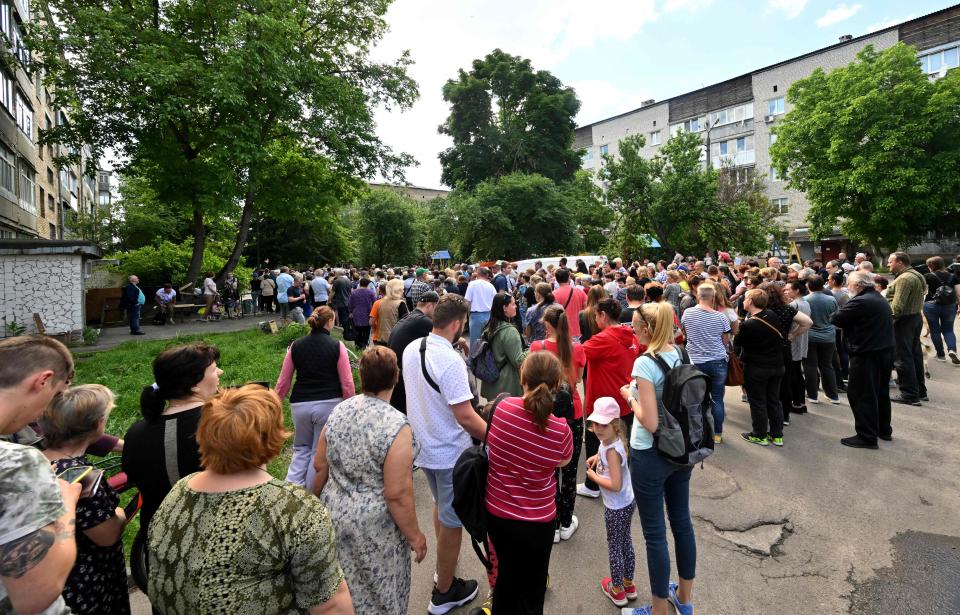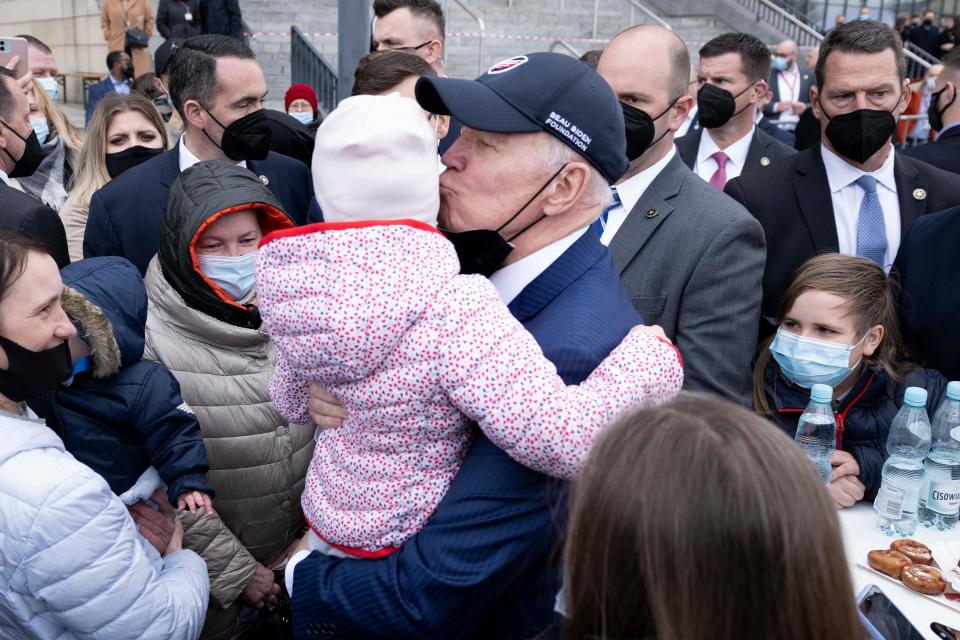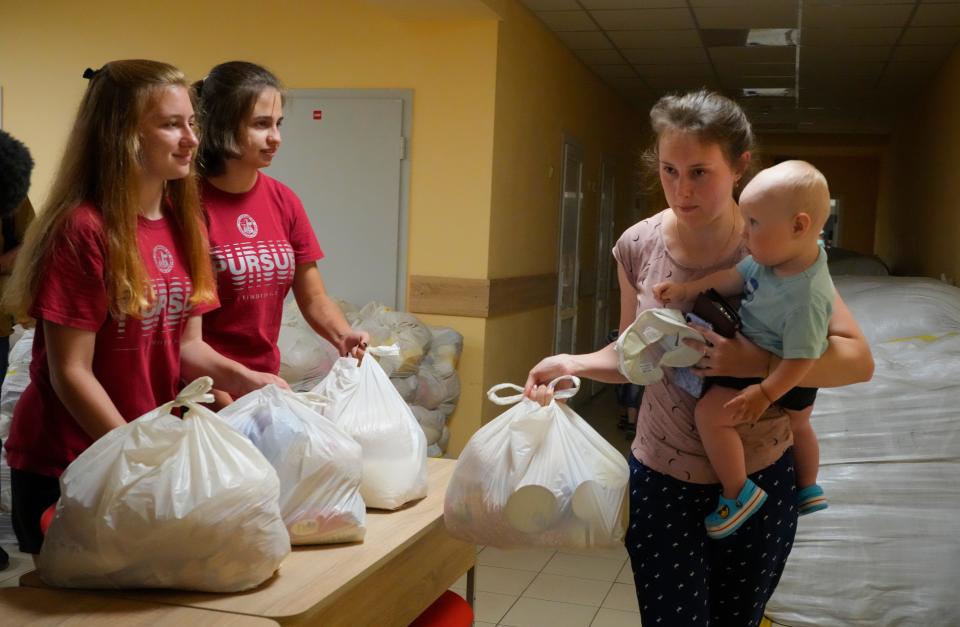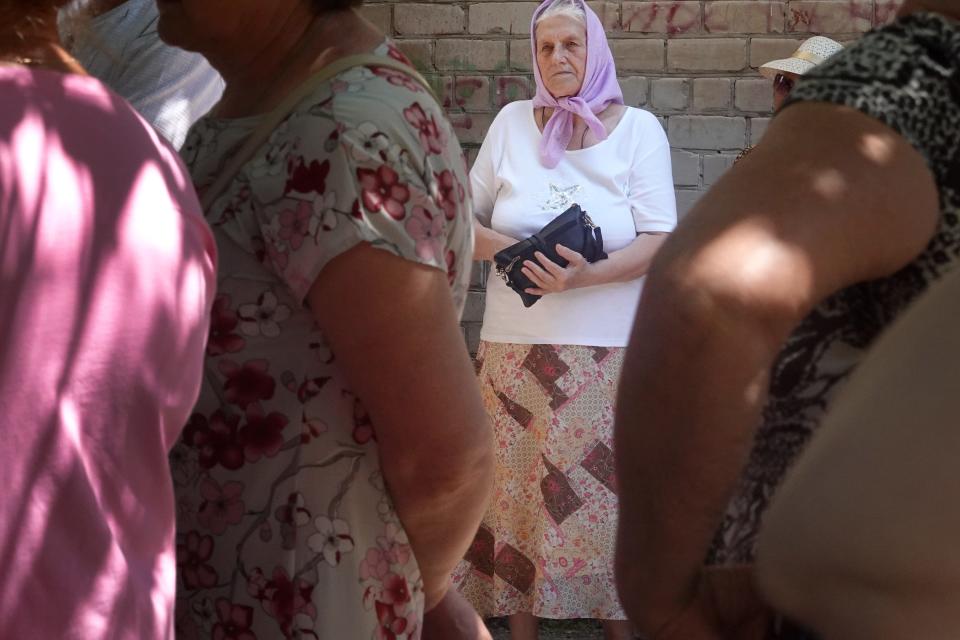'People are starving and thirsty': As the US sends aid to Ukraine, some say it's not flowing fast enough
- Oops!Something went wrong.Please try again later.
WASHINGTON – The day after Russia invaded Ukraine, World Central Kitchen was dishing up hot meals to the war's refugees.
Jose Andrés, the celebrity chief who founded the privately funded non-profit, assumed “the big guys” would show up soon after.
“But it took weeks for them to establish any presence,” Andrés recently told a congressional committee overseeing the billions of dollars the United States has committed to relief efforts in and around Ukraine.
Biden administration officials say there are vexing challenges to delivering those billions of dollars to those in need – from bureaucratic obstacles in Washington to treacherous conditions in a deadly conflict zone.
"Russia’s bombardment and shelling continues to damage the infrastructure needed to get aid to people – destroying roads, bridges, and railroads and making it difficult for aid workers to reach affected populations," said Rebecca Chalif, the spokesperson for the U.S. Agency for International Development.
She said the agency's partners are working at "great personal risk to reach the most vulnerable in hard-to-reach areas, but if humanitarian access does not improve, the already devastating situation will get even worse. "
Some Ukrainian aid workers and volunteers say they are delivering aid but could do far more with more direct U.S. help.
Serhiy Gorobtsov, an archbishop of the Ukrainian Orthodox Church, and his team is feeding more than 2,000 people every day in the refugee shelter in Dnipro, one of Ukraine’s major cities in the east. They're also sending food and clothes to parishes on the frontline towns of Pokrovsk and Konstiantynivka.
“I am running out of flour, sugar, oil, salt, porridge,” he told USA TODAY. He said a Swiss company sent 500 sausages and they ran out of them in one day. His group has received aid from an American-affiliated charity but not through any U.S. government channels.
“The logistics of deliveries is the worst issue,” he said, citing high fuel costs and the refusal of some transport companies to work with them.
Lives destroyed: Ukrainians' stories of loved ones lost in the war
Ukraine updates: Russians now control 80% of key eastern city, governor says; Russia finds buyers for its oil

Aleksey Androsenko, founder of a Ukrainian aid group called Plich-o-Plich, or Side by Side, said his group is delivering two trucks per week of hygiene and medical aid to Odesa.
“It takes us up to 48 hours of waiting in the traffic jams on the border,” he said. He would welcome coordination with American officials, he said, who could probably channel aid more quickly through other routes.
Olga Sytnyk, the humanitarian coordinator with the International Center of Ukrainian Victory, said she fears the U.S. is sending all its funds through established international NGOs instead of using Ukrainians who might be more familiar with dynamics on the ground – and more willing to risk their lives to get aid to those in need.
“U.S. billions are a great news … but so far they have not reached people on the ground,” she said.
Learn more: Mapping and tracking Russia's invasion of Ukraine
US aid to Ukraine could hit $53B.: Here's what it covers, how it compares and who pays for it
Tough balance: The need for speed vs. safeguarding U.S. tax dollars
In fact, with USAID support, the World Food Program has provided food and cash assistance to more than 5 million people in Ukraine through the end of May, according to Chalif.

Of the $2.65 billion in International Disaster Assistance approved in a March spending bill, more than $476 million has been given to groups to deliver food, water, shelter and other help to people in Ukraine, she said. The agency is still determining how to prioritize an additional $4.3 billion in disaster assistance included in the approximately $40 billion May package to respond to the crises.
Members of Congress have been pressing the administration to make more use of local organizations and non-traditional partners, rather than relying on United Nations' agencies like UNICEF and the World Food Program.
“We need to make sure that we’re getting this food assistance to groups that have already got a record of delivering on the ground in Ukraine,” Sen. Mark Warner, D-Va., told USA TODAY.
Lawmakers intended to send that message through language included in the May assistance package. Warner also put together a bipartisan letter, reinforcing that position, to Samantha Power, the administrator of USAID.
“We wanted to take some level of risk on this,” Warner said, “because the groups that are delivering the most meals on the ground are not necessarily the usual suspects in food relief in other crises.”
During House and Senate hearings last month, Power said USAID has a tricky balancing act. The need to dispense huge amounts of money – while avoiding misuse of the funds – has meant very large contributions went first to the major United Nations organizations with which the U.S. has longtime relationships.
Since then, however, USAID has been trying to diversify its partnerships.
“We just want to make sure that we are going to be faithful stewards of taxpayer money,” Power told a House spending panel in May. “At the same time, we are looking for speed and nimbleness.”
Military assistance: Biden is giving Ukraine the deadliest weapons yet. Will it make a difference?

Jake Kurtzer, an expert on humanitarian assistance at the Center for Strategic and International Studies, said there are longstanding, well-intentioned barriers that make it difficult for local organizations to receive U.S. funding.
“If you want to work with USAID, you need to have a government contracting number. You need to sign a whole bunch of paperwork that says you’ve read and understand all these different compliance things,” he said. “If you are a Ukrainian church organization that quickly shifted to doing meal service, is your priority to continue to do meal service or to get online and fill out compliance paperwork?”
Kurtzer said the frustrations he’s heard about the way assistance is being distributed in Ukraine are understandable, though he still gives the administration a lot of credit for its overall response.
“To set up the administrative and bureaucratic infrastructure to respond on a scale of what we’re seeing so far does take a certain amount of time,” Kurtzer said. “Just the numbers that have been reported already from the World Food Program, from the IOM (International Organization for Migration), and from some of the NGO partners are impressive. But there’s always more that could be done.”
The biggest obstacle? Russia's refusal to provide safe corridors
The biggest challenge to helping Ukrainians, according to both Power and outside experts like Kurtzer, is not finding the right partners. It's Russia’s refusal to follow international law and allow aid agencies access to injured and starving civilians.
"While humanitarians want nothing more than to be in the most dangerous places, and to be accessing the people most in need, when Russian forces say `No, you can't travel, we won't guarantee your security,' it makes it really difficult to overcome that," Power told Congress last month.
There have been at least 256 attacks on health care facilities and one in six UNICEF-supported “safe schools” in eastern Ukraine have been damaged or destroyed, according to Afshan Khan, UNICEF’s regional director for Europe and Central Asia.
“The needs are exorbitant and huge,” she said.
Maps show how the war is unfolding: Russia gaining control of another crucial eastern Ukraine city.

Mark Lowcock, a former under-secretary-general for humanitarian affairs at the United Nations, has additional concerns, chiefly the possibility of widespread famine in other parts of the world if the war grinds on and Ukraine's wheat remains blockaded. That could cost millions of lives, he said.
“I think people now can see the risk, but the response so far is inadequate,” said Lowcock, author of the recently published book “Relief Chief: A Manifesto for Saving Lives in Dire Times.”
Andrés: 'People are starving and thirsty in a crisis'
It has taken as long as a year for a new organization to win approval to work with USAID in the past. Even before Russia invaded Ukraine, Power hoped to change how her agency delivers assistance. In a November speech, she set a goal of putting at least 25% of U.S. humanitarian aid directly in the hands of local partners within the next four years. Despite past efforts to increase the share of funding going to such partners, it had risen to just 6% in the last decade.
“There is a lot of gravity pulling in the opposite direction,” Power said in November. “But we have got to try.”
USAID is also encouraging the major international organizations to work with local groups to deliver aid. The World Food Program, for example, is partnering with 200 organizations of which a “significant share” are local groups, Power recently told Congress.
“I think they were a little slow at the beginning ... ,” she said, “and now they’ve staffed up.”
UNICEF, which has “significantly scaled up” its response in the last 100 days and is still expanding, is almost “completely working with local partners” to serve areas that are difficult to reach, according to regional director Khan.
UNICEF has set up more than 100 one-stop-shops where Ukrainian families can get supplies, information, therapy, parenting support as well as a place where children can play safely and experience some normality.
The centers are named for the Ukrainian word for "together," to reflect the close partnership with local organizations. UNICEF provides the design and structure, but the services are delivered through municipalities or local civil society organizations. That will help build sustainability, Khan said, because UNICEF won’t be able to have the long-term, boots-on-the-ground presence that the magnitude of the crisis requires.
“The psychosocial trauma that children have faced is going to be for years now,” Khan said. “They're going to need support. And that will require local capacity to engage and continuity. So we see this as extremely important.”
Watch: A family sings in Sumy. Six were killed when a missile hit their home in spring 2022.

While local actors “may be a bit more nimble in getting access,” she said, UNICEF provides the scale needed to work across such a huge country and the ability to evaluate how funds are being used.
“I would never underestimate the capacity of local actors,” Khan said. “But those supplies have to come from somewhere, and they have to be delivered.”
Catholic Relief Services has been working with a local group, Caritas Ukraine, to distribute assistance that is funded in part by more than $52 million in private donations contributed by Americans since February.
Partnering with local staff is both an opportunity and an obstacle, said Conor O’Loughlin, Catholic Relief Services’ representative in Ukraine and Moldova. Many workers were themselves forced to flee areas under attack.
“That inevitably creates a level of distress and difficulty for Ukrainian humanitarian workers,” O’Loughlin said, “and yet we still see this commitment to supporting their fellow citizens in their time of need.”

Of the nearly $5 million in USAID funding the group has received to feed refugees in Moldova, more than half has been spent and the rest will be gone within about another four to five weeks. Because of how quickly the U.S. funds were released, O’Loughlin said, his group began its response faster than in other crises.
Andrés, the World Central Kitchen founder, told a House oversight committee panel this month that the United Nations teams’ approach is too top-down instead of bottom-up, so Ukrainians aren’t getting the right kind of assistance and they haven’t gotten help quickly enough.
“The current system just does not work when people are starving and thirsty in a crisis,” he said. “We need a more agile and effective system to deliver it.”

This article originally appeared on USA TODAY: Ukraine aid: How much U.S. assistance is reaching those in need?

